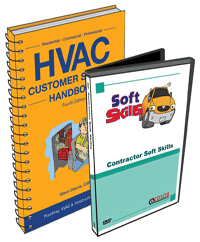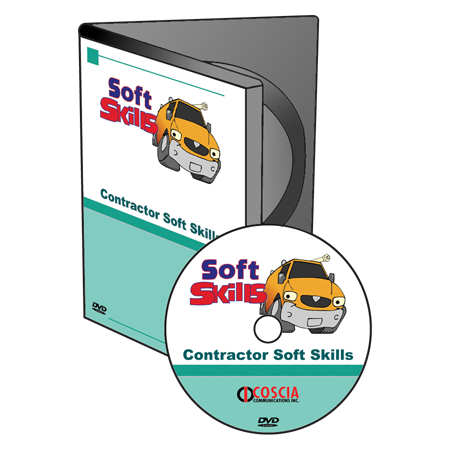Work is carried out here in a logical sequence. Slow times are used to work on the company property and to prepare for the coming season. The workload shifts to these other projects, but it doesn’t come to a halt. The company plants the seeds for future work with creative marketing strategies. And at all times, technician safety is a top priority.
For the above reasons and more, Keil Heating and A/C is one of the seven winners in <>The News’ 2000 “Best Contractor to Work For” contest.
It has a warm family atmosphere too, which shouldn’t be surprising. Barbara’s grandfather, Henry Keil (pronounced Keel), started the company as a coal and ice delivery business in 1908. It picked up fuel oil and air conditioning along the way; sold off the fuel oil business in the 80s; and is now a residential hvac company.
‘Mr. White Shirt’
Steven Smits started with Keil 16 or 17 years ago, although he has been around much longer because his father used to work for Barbara’s dad. Steven has never worked for any other contracting company.He is a member of RSES and of the Riverdale Businessman’s Association; this year he was nominated to be president of the group.
As the company’s service manager, he is in charge of tech education, field work, and follow-ups. He knows what good technicians want. “They don’t want any confrontation or confusion. They like smoothness and logical sequences, fair pay and benefits, and safe conditions.
“The hardest thing is to get a technician to accept change,” he continues. At weekly service meetings, Steven says he can tell whether or not the techs are “getting it.” While the technicians sometimes go to service schools, most of the time he is sent to the schools, brings the information back, then trains the others himself. The smaller class size helps streamline the learning process.
At the techs’ regular service meetings, they may discuss topics like zone valve wiring, relief valve spilling, or water pressure. For example, the City of Riverdale recently increased the pressure on city water lines; the result is that new water heater installations may need an expansion tank.
Among their benefits, all field employees get a uniform and laundering service. There was some discussion over uniform shirts when the choices were first considered, Milt says; it was pinstripe vs. white. White looked nice, but it wouldn’t stay nice-looking for long, so the company decided on pinstripes for the techs — all except Steven, who gets to wear a white shirt. Now when they rib him, the guys call him “Mr. White Shirt.” (And they’re really happy that now you know it, too.)

Time That You Waste Is Wasted Time
The colder seasons are typically slowest for many contractors. Keil is no different. However, the company uses that time for fulfilling service agreements, training staff, and getting things prepared for the often hectic summer months.Techs spend time fabricating their own drain pans, practicing working on the metal. They make 100 in preparation for the coming season. They also construct zone valve manifolds for hydronic systems; not only does this keep their soldering skills fresh, it also makes use of smaller lengths of copper tubing cut in other installations.
They make IAQ duct access patches in three sizes. By including a one-piece gasket seal on the patches, all duct-cleaning techs have to do is press it into place to secure it, freeing up both hands for the rest of the installation.
Organization permeates the company. “Everyone is clearly aware of what their specific job requirements include and what is expected of them on a daily basis,” says Milt. “The key to a good day’s work is organization. Knowing exactly what he or she is going to do on a job makes life much easier for the technician. This allows the technician to fully focus on helping the customer and completing the job at hand.”
Techs go out with a written plan for each job; every part, piece, component, and tool required has been checked off. A storage room has all the items organized (color-coded, of course); the pull system allows less-experienced staff to put a kit together.
“People that we attract see that we are organized,” says Milt. “We go out with every part we need. It’s set up to be as easy at the jobsite as possible.”
At the end of each job, a complete review with the customer helps head off misunderstandings and problems. Techs are budgeted time to teach customers how to operate and maintain the system. Then there’s a follow-up phone call from the telemarketers, headed by Peggy Sauter. If there’s a problem, it is addressed. If there isn’t, the telemarketer introduces the company’s service agreement.
A company tune-up book (a laminated flip-book to take on the job) gives step-by-step instructions for performing maintenance procedures. An example of the detail is step one in the boiler maintenance instructions: “Park in front of the customer’s house,” it says, so that they can see the company name on the truck as they look out the front door to let in the tech.
Lead technician John Niper doesn’t like things that are disorganized. He found out just how much when he left Keil to work for another company. After a few days, he called and asked if he could come back, according to Milt.
John was put in charge of a major winter project three years ago. The company was going to push back the shop area some and build a training room, and John’s carpentry skills suited him to the task. The time spent building that room has paid for itself 50 times, Milt says.
Keeping It Fresh
“We almost always hire entry-level people and plan their training and career paths for them,” Milt says. “Technical schools in our area are not producing the quality or quantity of students that they have in the past. We look everywhere, mostly outside the industry, and we look for personality and attitude first, technical skills second.”There is a great deal of cross training. “No one should have to stay a duct-hanger for all his career,” Milt says. Techs learn how to install and service forced-air and hydronic systems. (The company deals with mainly Goodman/ Janitrol and sometimes Trane on the air side, and for hydronic systems, Peerless brands.)
Beside the tech meetings and in-house service training, em-ployees receive customer service training outside the company, safety training inside and outside of the facility, manufacturer training in-house, and sales training. This does not include a well-organized and detailed mentoring program for new coworkers in the maintenance and service areas.
Making Hay
The contractor looks at certain situations as possible advantages. For instance, when a local retailer recently went out of business, Milt bought some very nice stock shelving and heavy-duty ladders from the liquidation sale.When the CPSC issued its warning about high-temperature plastic vent (HTPV) piping, Keil sent registered letters to customers with this product in their homes.
“Every one that we’ve put in, we’ve removed,” says Barbara. In addition, “75% to 80% of the people we got in to do this work, we sold maintenance agreements to,” she says. Techs know to look for HTPV at jobsites of new customers. They’ve also had several referrals from customers who have had their HTPV removed by Keil.
When business starts to slow down, the telemarketers start to pick up the pace by calling existing customers and reminding them of services they may need — things that the last visiting technician may have noted on the invoice. They work to keep their calls pertinent and unobtrusive.
Safety First
But perhaps most important to the techs is the care the company takes for their safety. Saying that you care is one thing, but the proof is in the wasp spray, cases of which the company has stocked on its shelves. Summer heat is also treated with respect.“Our busy season is during the summer months of May, June, and July,” says Milt. “We try to schedule all of our attic service and maintenance calls in the morning hours, before the high temperatures of the day. Once the temperature goes up, we try to keep our technicians working in the cooler basements.”
The company also provides its technicians with plywood flooring in their trucks “to ensure that they always have a safe surface to work on in attic situations,” Milt says. “We do charge to install the attic flooring. We also provide our customers with documentation showing them that lack of proper flooring is a state code violation.”
In addition, “During very hot or busy days, our service manager will visit each technician during the day to ensure that they are not being adversely affected by the heat or humidity and to provide them with Poweraid-type drinks.”
To avoid burnout, every technician has a complete weekend off at least every other weekend. And all company trucks are air conditioned.
Finally, “Every coworker who is provided with company-owned tools is provided with tools that are in excellent working order,” Milt says. This includes trucks, hand tools, worker-assist tools, even office computers. And it includes their own mental tools and skills, which the company helps keep sharp.
As Steven Smits says, “Milt has never let anyone take out a bad Sawzall.”
Sidebar: Good Company
Keil Heating and Air Condition-ing is “a member in good standing” of ACCA, the Better Business Bureau, and Contrac-tors Success Group. The com-pany has won CSG’s Contractor of the Year award twice.Sidebar: Just the Facts Keil Heating and Air Conditioning, Inc.
Publication date: 02/26/2001
Web date: 06/18/2001







